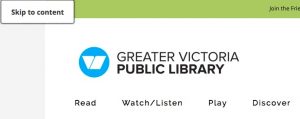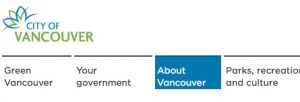On June 21st, a historic event happened in Canada; the Accessible Canada Act received royal assent. When it comes into force, the law will require the Canadian government to make sure its facilities, services, goods, and employment opportunities under its control are free from barriers that disadvantage people with disabilities.
Although this historic law does not apply to organizations under provincial or municipal control, it still gives library professionals across Canada an opportunity to reflect on barriers.
This essay draws attention to a barrier in BC’s physical environment recently reported by the CBC and then reflects on barriers in BC’s digital environment as well as strategies for removing them.
The Accessible Canada Act
How did the historic Accessible Canada Act become a reality? The driving force behind the legislation was Barrier-Free Canada. The group built a non-partisan coalition of over twenty national disability organizations calling for a Canadians with Disabilities Act.
The act was introduced in the House of Commons on June 20, 2018 as Bill C-81, with the short title The Accessible Canada Act. As the bill wove its way through the legislative review process, the House of Commons heard feedback from 59 witnesses, including spokespeople from disability rights groups.
- British Columbia Aboriginal Network on Disability Society (written testimony, video with ASL starting at 18:50)
- Barrier-Free Canada (written testimony, video with ASL, starting at 9:04)
- Council of Canadians with Disabilities (written testimony, video with ASL at 19:12)
- Accessibility for Ontarians with Disabilities Act Alliance (written testimony, video with ASL, starting at 8:05)
While the words of these spokespeople enter into Canadian legislative history, what barriers are British Columbians speaking out about locally?
Physical Barriers: Examples from Port Coquitlam and Victoria
Recently, the CBC reported that the current designs of standard accessible washrooms make it difficult for 10-year-old Amy Diaz of Port Coquitlam to enjoy recreation centres, movie theatres, swimming pools, or other public places. Wearing a t-shirt with the word “KIND”, Diaz reminded readers that social spaces beyond the home should be welcoming to everyone.
How can the standard accessible washrooms in BC be improved? Amy’s 12-year-old sister, Lucy Diaz, found a solution in the Changing Places Consortium. This UK-based group has been highly successful at campaigning for more accessible washrooms.
The Diaz sisters are not alone in drawing attention to the Change Places example. Brentwood Bay’s David Willows, founder of the Changing Places BC facebook group, has also been advocating for inclusive washrooms in BC. According to the CBC, the Victoria Airport Authority, which is owned by the federal government and subject to the Accessible Canada Act, was quick to agree to Willows’ request for a Changing Places washroom.
The day after the CBC’s report, Willows addressed Victoria City Council at a Town Hall on accessibility. He explained the importance of Changing Places washrooms (video at 28:22, with ASL). Unlike the Victoria Airport Authority, the City of Victoria is not subject to follow the Accessible Canada Act. However, according to Willows, the city says it will include a changing places type facility as part of the city’s Crystal Pool.
While the Diaz sisters and Willows draw attention to barriers in BC’s physical environment, what about barriers in BC’s digital environment?
Digital Barriers in British Columbia
In March 2019, at UBC’s Vancouver campus, Dr. Heidi Janz and Dr. Michelle Stack gave a public lecture titled “How (Not) to Train Your Technology… and Other Dragons.”
They began by documenting technical barriers in the building’s classrooms. They then introduced terminology, such as “ableism,” which is a widely held belief system that values certain human physical and mental characteristics over others.
They also raised a question about authority. Who gets to decide, for example, when or which assistive technology is needed? Dr. Janz also explained how the impulse “to fix something that is related to a person’s disability can often be rooted in ableism.”
Dr. Janz and Dr. Stack also questioned how ‘problems’ get framed. They explained how sometimes able-bodied people feel uncomfortable with disabilities. Rather than treating these feelings as a problem, able-bodied may frame the disabled person as needing help. From this perspective, assistive technologies can be pushed onto the disabled to make abled-bodied feel comfortable rather than being chosen by the user because it makes it easier to do the things they want to do.
While Dr. Janz’s and Dr. Stack’s focused on physical spaces with technical equipment and assistive technologies, they did not address barriers created by websites. Yet in Canada, an inclusive web has been recognized as a right. In 2012, the Federal Court of Appeal upheld the decision that the Canadian government violated Donna Jodhan’s equality rights protected by the Charter of Rights and Freedoms. Online government services were not properly designed to let Jodhan, who is blind, benefit from them.
Checking web accessibility
How can you check if a website or vendor product is accessible? I find this question vague and prone to unclear responses. I prefer the more precise question: “How does it conform to the WCAG 2.0 requirements?” The Web Content Accessibility Guidelines (WCAG) 2.0 is a standard for making web content more accessible for people with disabilities. It is a widely used standard around Canada and the world.
Here are two quick WCAG 2.0 checks you can do with one finger.
Check 1. Press the tab key once
Go to a website that has a menu or navigational area at the top. Press the tab key once. If you see a “Skip to content” link, that’s a good sign.
alternative text: Long description in following paragraph
source: Greater Victoria Public Library
In this screenshot, the first time the user presses the tab key, the Greater Victoria Public Library website display a link labeled “skip to content”. When they press enter, the keyboard focus will leap over the lengthy navigational menu that follows. This is helpful for anyone who can’t see the mouse cursor or control the mouse well, such as a blind user or limited control of their hands. Without the skip link these users would have to press the tab key about 90 times on every page just to get to interact with the main content.
Check 2. Press the tab key a few more times
Press the tab key a few more times. Is the link with the keyboard focus highly visible? If so, the page is using a reliable technique for making a page usable for people who can’t use a mouse.
alternative text: Long description in the following paragraph
source: City of Vancouver
This screenshot shows the City of Vancouver’s website. The “Your government” menu option is given highly visible background color which tells you it has the keyboard’s focus.
alternative text: Description in the following paragraph
source: City of Vancouver
This screenshot shows what happens when you press the tab key. The keyboard focus advances to the adjacent “About Vancouver” menu link, which is given the highly visible background color. This tells the user which link has the focus.
There are many more checks that need to be done. Depending on the complexity of the site, it can be time consuming. While testing tools can help, you can’t expect them to do all the work for you.
Beyond a checklist mentality
Web accessibility involves much more than checking off a bunch of boxes. A checklist mentality assumes someone else has all the answers. This assumption can result in neglecting other responsibilities required of us.
WCAG 2.0 has flaws. Its editors acknowledge that it does not address barriers faced by “individuals with all types, degrees, or combinations of disability, particularly in the cognitive language and learning areas.” The standards editors, in fact, encourage web authors “to seek relevant advice about current best practice to ensure that Web content is accessible, as far as possible.”
These flaws should not be used as an excuse to avoid understanding WCAG 2.0. Although it’s not terribly entertaining to read, WCAG 2.0 offers lots of valuable advice. In my opinion, we’re better off to see web accessibility as an expanding horizon rather than a finish line. (In fact, WCAG 2.0 was updated to version 2.1 in 2018.)
Here are three additional areas of web accessibility that libraries need to champion:
Area 1. Documenting accessible patterns and common problems
To help web developers build more accessible web content, the WCAG 2.0 editors published a collection of reliable techniques (i.e., design patterns) and a collection of tests to detect common problems.
While these collections are immensely useful, they were never intended to be comprehensive. The WCAG 2.0 editors have encouraged the public to submit examples. Unfortunately, the last reliable technique for a WCAG 2.0 success criterion was submitted over 10 years ago, on May 8th, 2009 and the last WCAG 2.0 test to detect a problem was submitted on October 6th, 2016. Overall, the WCAG 2.0 pattern library has not been officially updated since October 7th, 2016.
To support our public mission of access to information, libraries need to be vocal champions that the building blocks of the accessible web are (a) designed by or with people with disabilities and (b) shared widely for web developers to use. Perhaps the new Canadian Accessibility Standards Development Organization, established under the Accessible Canada Act, could develop these design patterns?
Area 2. What assistive technologies do users rely on?
Libraries also need to be champions for creating web content that is compatible with the assistive technology users rely on. This requirement is formally referred to as “accessibility supported.” This implies, however, that we have a clear idea of the assistive technologies users rely on.
This requirement is not an easy one for web developers to meet. As the WCAG 2.0 editors explained, “this is a complex topic and one that varies both by environment and by language. There is a need for an external and international dialogue on this topic.” Library leadership and library associations should be kick-starting this conversation by lobbying regional and national governments to assess the state of assistive technologies in Canada.
Area 3. Telling vendors to fix problems
Canadian libraries subscribe to a lot of vendor products. Canadian library consortia should have a transparent strategy for ensuring vendors meet web accessibility requirements.
An example of consortial strategy is the Big 10 Academic Alliance’s e-resources project. As a consortium of 14 universities in the United States, the Big 10 Academic Alliance commissioned accessibility audits of major vendors platforms and posted the results online.
Moving towards a “one-size-fits-one” web
Ultimately, I think Canada needs to move towards a web infrastructure that lets individuals with disabilities adjust their digital environments to make it easier to do the things they want to do. This is needed because Canada’s Charter of Rights and Freedoms is an individual-level standard. This design paradigm is what Jutta Treviranus (Inclusive Design Research Centre, OCAD University) calls ‘one-size-fits-one.’
Is such an infrastructure far fetched? Not at all. Canadian libraries should take a look at the Global Public Inclusive Infrastructure (GPII). Co-directed by Jutta Treviranus and Gregg Vanderheiden (Trace Research & Development Centre, University of Maryland), the GPII is already developing this ‘one-size-fits-one’ infrastructure and has spun it off as Morphic.
Coming soon: Morphic
Raising the Floor – US (RTF-US), as part of the GPII, will soon be launching Morphic. A software extension to the operating system, Morphic makes it easier for users to discover accessibility features, save those preferences securely to the cloud, and apply them seamlessly on other computers where Morphic is installed. An ‘install on demand’ feature is also being developed, where Morphic would install a user’s preferred assistive technology on whatever computer they are using and automatically configure it according to their preferences.
This means a teen who needs her computer configured in a unique way could easily move between a family computer at home, a workstation at a school computer lab, and a computer at her local library. At each location, Morphic would automatically apply her accessibility preferences to change the computer to the way she wants it. It also means (with Installation on Demand) that she could approach any computer at a library and have the assistive technology she needs show up on it – rather than just having the assistive technology be on one or two computers in one room at the library.
Morphic is currently finishing its piloting phase in libraries (Chourasia, et al., 2015). It will be available to libraries around the world in the near future. If you’re interested in learning more contact Gregg Vanderheiden ([email protected]).
Conclusion
In Our Own Selves: More Meditations For Librarians, Michael Gorman provides a collection of short essays about librarianship, each concluding with a brief message to reflect on. One stands out as relevant here: “I will make my library a welcoming place” (p.134).
Environments, whether physical or digital, that have barriers that perpetuate disadvantages are anything but welcoming – they are discriminatory.
Whether by trying out the two checks described in this essay, or by pursuing one of the additional areas of web accessibility responsibility, or by reaching out to get involved in Morphic, there are lots of ways for BC libraries — and all Canadian libraries – can make libraries more welcoming.
References
Chourasia, A., Tobias, J., Githens, S. & Vanderheiden, G. (2015). The Library-GPII-System: Reinventing accessibility in libraries. ASCLA Interface, Spring.
Mark Weiler is the Web and User Experience Librarian at Wilfrid Laurier University. He is also a member of the Morphic Library Advisory Group. Mark is a certified Web Accessibility Specialist through the International Association of Accessibility Professionals as well as the facilitator of the Web Content Accessibility Guidelines community of practice under the Canadian Association of Professional Academic Librarians. Mark has given testimony to the House of Commons Standing Committee on Access to Information, Privacy, and Ethics. He completed his PhD from Simon Fraser University and served on the Board of Directors for the BC Freedom of Information and Privacy Association.




